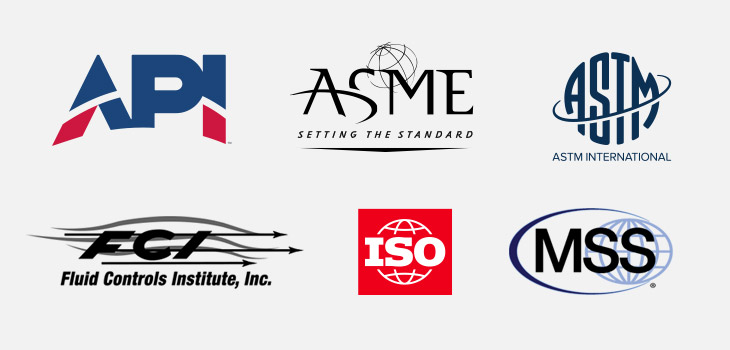For consistency amongst manufacturers, valves are designed to meet established standards. These standards are set for valve performance, design, materials, and functionality. This article aims to cover the organizations responsible for establishing standards in valve manufacturing, along with common valve ratings and testing procedures.
Valve Standards Organizations
Valve standards are created by private entities that develop best practices in the use of valves and piping systems. Some of the organizations that are most referred to when discussing valve standards are the American Petroleum Institute (API), the Manufacturers Standardization Society (MSS), the International Organization for Standardization (ISO), the American Society of Mechanical Engineers (ASME), and the American Society for Testing and Materials (ASTM).
American Petroleum Institute (API)
The American Petroleum Institute is the only national trade association that represents all aspects of America’s oil and natural gas industry. The API began around the first World War when the US government and the oil & gas industry worked together for the war effort. API is the go-to organization for valve testing in North America.
Manufacturers Standardization Society (MSS)
The Manufacturers Standardization Society of the Valve and Fittings Industry is a non-profit technical association. It develops international codes and standards for valves, actuators, pipe fittings, pipe hangers, pipe supports flanges and associated seals along with many other components in piping systems.
MSS is accredited by ANSI (the American National Standards Institute), which subjects MSS standards to review.
ISO
The International Organization for Standardization is the largest developer of voluntary international standards. The ISO is tied to 167 national standards entities worldwide. International standards are important because they are critical for international trade as they ensure consistency. This comes in the form of instituting product quality, safety, and efficiency to protect consumers.
ASME
The American Society of Mechanical Engineers was founded in 1880 as a society for engineers in response to numerous steam boiler pressure vessel failures. This standards organization has been improving the safety of equipment used in manufacturing and construction, particularly boilers and pressure vessels, for years. Regarding piping and valves, ASME covers these topics in documents such as B16.34, B16.5, and B31.1 to name a few.
ASTM
The American Society for Testing and Materials was founded near the beginning of the 20th century. Today ASTM is one of the largest standards organizations in the world, with 30,000 members. ASTM’s scope ranges from nanotechnology to skiing. There are six sets of standards: testing, specifications, classification, standard practice, guides, and terminology.
ASTM primarily sets classification, practice, and testing standards for valves. These standards relate to valves, the materials that are used, and even the applications they are used in.
Control Valve Standards
The Fluid Control Institute (FCI) is an association that assists buyers in understanding fluid (liquid or gas) control and conditioning equipment. FCI currently covers control valves, instruments, pipeline strainers, regulators, secondary pressure drainers, solenoid valves, and steam traps. Surprisingly, the industry uses the allowable leakage rates of FCI 70.2 for isolation valves, even though it is a standard for “Allowable Leakage Rates for Control Valves”.
